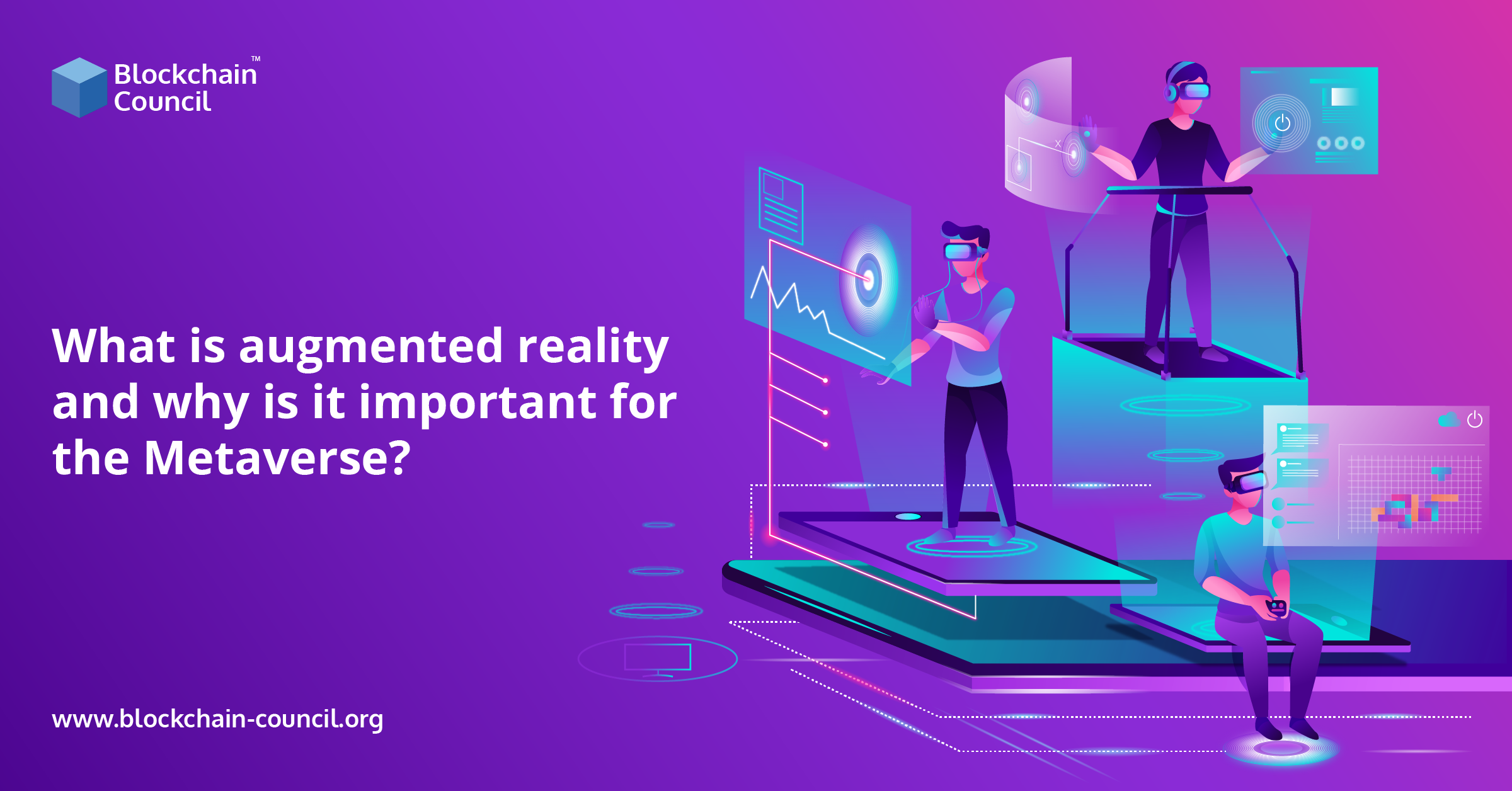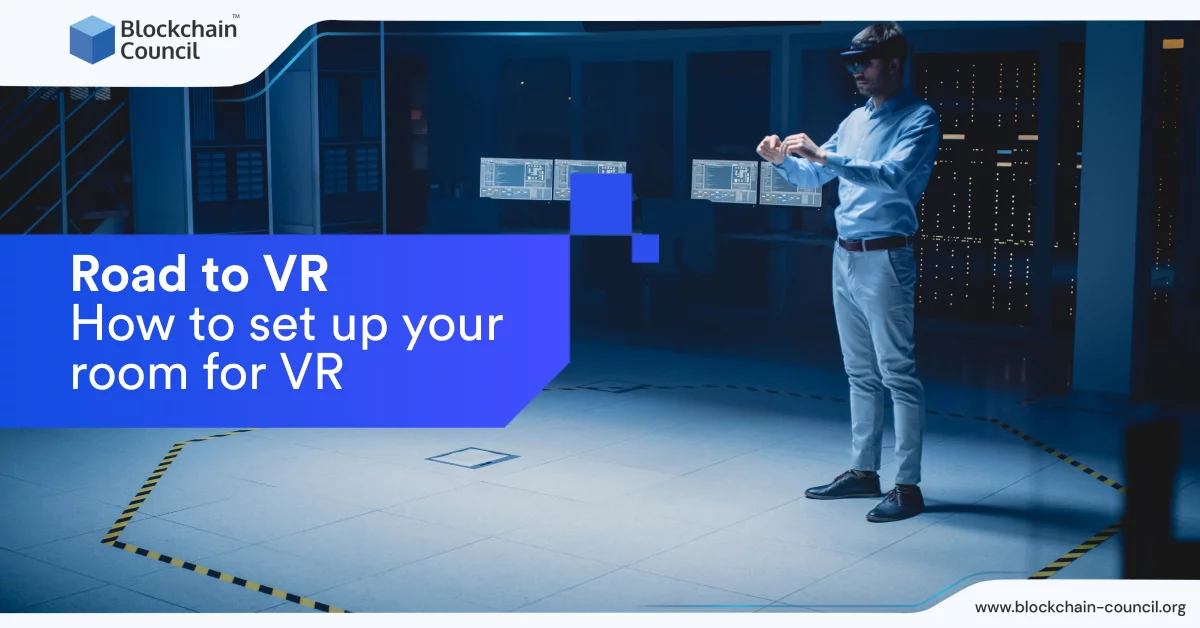
- Blockchain Council
- January 16, 2023
Humans have always been curious about the unknown, unraveled, and unproven. We have this constant urge to go beyond reality and discover what hides beneath the darkest layer of veils in the physical world. The undying curiosity of some of the brightest minds led to the development of our society and pushed us to become the sophisticated beings we are at present.
With each tiny step, we moved one step closer to a world of our dreams where everything seems new and a notch higher than the predecessor. Technological innovation revolutionized the whole channel we were accustomed to for the longest span. It brought us to the forefront of an infrastructure that is unique, powerful, and encourages innovation. The fast expansion of digital resources, decentralized tools, and the virtual world ecosystems shows how eager we are to take the next big step in the Extended Reality realm.
Talking about the most popular technological trends of the past decade brings us back to the concept of ‘Augmented Reality’ or AR which became a rage amongst people across the globe. The technology came to light in 2016 when the AR-supported game Pokémon Go introduced users to a new form of gaming. It made it possible for players to interact with their favorite Pokémon characters superimposed on the real world through a smartphone. Where this was the first step toward Augmented Reality, today we can see the industry unleashing new opportunities for growth and innovation. AR has made a striking use-case in the world of Metaverse technology as well.
If you are still wondering what exactly AR is and how it is shaping the Metaverse blockchain space, then you have landed at the right place. We are here to help you learn more about this novel technology bliss that has gifted the world some of the best tools and resources for use. So, without much ado, let’s start:
What is Augmented Reality?
As the name suggests, Augmented Reality is a technology built to augment reality. In other words, AR allows users to experience the real world in an enhanced version wherein one can find interactive digital elements. An AR app will facilitate visual, auditory, and other sensory interactive information in real-world ecosystems to enhance the experience for users.
The most widely used Augmented Reality applications and software work seamlessly on smartphones. They help users to access a digital augmented world in a few simple processes. All they need to do is to switch on their smartphone cameras, view the world around them on the phone screen, and depend on the AR app to enhance the experience of viewing the real world. This is done in multiple ways via digital overlays such as:
- Inclusion of labels
- Superimposing pictures, 3D models, and other digital information
- Insertion of real-time directions in navigation apps
- Fluctuating colors depending upon situational changes
- Changing user appearance or their environment using filters on Snapchat, Instagram, etc.
Today, a plethora of devices can support AR and the list is constantly growing. This includes screens, glasses, handy devices, and head-mounted displays. Unlike Virtual Reality where we explore virtual spaces, AR exposes us to an ecosystem that integrates digital components with the existing environment. It has evolved as one of the fastest expanding XR technologies and a major reason for this is its widescale accessibility. The technology is so widely used that at present one can easily find a big volume of consumers having a tool giving access to AR right in their pockets.
High-tech smartphones stuffed with intelligent processing capacity and high-resolution cameras are the best incubators for Augmented Reality tools. However, they are not the only interface to experience augmented reality as the scope of this technology is huge. Coming out of the gaming sector, AR has proliferated into a variety of domains and proved its mettle in revolutionizing them. For instance, Augmented Reality algorithms are put to use for assisting surgeons in medical procedures, and guiding engineers while making the best use of advanced technology. The use of the modern-day, advanced smart glasses designed by developers offers exposure to a more hands-free experience for users.
For a detailed article on Metaverse, you can refer to “What is the Metaverse? Step-by-Step Beginners Guide 2023”
Where did AR have its Roots From?
It is needless to say that AR is a futuristic technology that has its roots growing deeper and deeper with every decade span. Back in the 1990s, we witnessed the technology in its basic form via heads-up displays used in military aircraft for giving information about the direction, speed, and height of planes. A major blow came in 2009 when the MIT Media Lab group launched the world’s first wearable gesture interface called SixthSense. The device combined the real world around us with digital elements.
Further, in 2013, tech giant Google came up with the world’s first smart glasses branded as Google Glass. Despite much hype, the product failed to reach its full potential in the market. The firm didn’t receive the success it was looking for. Interestingly, the most vivid experimentation with AR began in 2016 when renowned companies launched innovative projects using the technology to lure customers. As mentioned above, the AR game Pokémon Go became the first significant breakthrough for the AR industry. In no time, it emerged as a global sensation and brought AR to the much-needed limelight. The users enjoyed access to an immersive technology that enhanced their usual experiences. Since 2016, AR has grown tremendously well and has opened doors of new opportunities for individuals as well as the corporate world.
Are There Multiple Versions of AR?
Ever since the growth of Augmented Reality technology, there are discussions on different types of digital augmentation experts can explore. The different types of AR are:
Marker-based AR
These apps are triggered by exclusive physical pictures or markers captured by the smartphone camera to place the digital components on top of it. A marker can represent an object or a visual like a logo or QR code.
Markerless AR
They do not rely on markers and allow users to choose where to display the content. These apps depend on the camera, GPS, compass, and accelerometer to collect information about the surroundings. The various types of markerless AR technology include:
-
Superimposition-based AR
They identify the object in the real world and replace it from the original view, either partially or completely.
-
Projection-based AR
It does not require a display tool as it projects light onto a surface to showcase digital objects.
-
Location-based AR
They provide augmentation in certain places by using the GPS and compass for positioning the virtual object at the desired place. Pokemon Go was based on this AR technology.
How does AR work?
- To overlay digital components in a real environment, Augmented Reality requires a device with an in-built camera and AR software. One can use a smartphone, a tab, or smart glasses.
- The software employs computer vision for processing the video stream taken by the camera. This helps to recognize objects in the real world. The process helps the AR channel to project digital content to a particular place.
- The tool then projects the virtual elements on top of the original environment via the display device in a real-like setup.
Use Cases of Augmented Reality
Retail
Augmented Reality has opened a new era of retail industry. The technology allows customers to try products without purchasing. For instance, retail giant IKEA’s IKEA Place app helps users to place furnitures in multiple spaces at their homes digitally so that they can visualize the entire setting before the purchase.
Education
With AR apps, we can make learning more interactive and engaging for students. The technology helps to make educational tools more accessible and adaptable. Teachers can use visual representations for explaining a particular topic.
Manufacturing
It facilitates speedy prototyping and remote aid in maintenance processes. AR helps to streamline the manufacturing cluster while reducing the burden on the staff members.
Logistics
The use of AR in logistics industry helps to enhance the overall efficiency of the system. It also helps to reduce costs involved in warehousing and transportation. AR-supported tools can guide staff in a warehouse and speed up the working process.
Use of Augmented Reality in Metaverse Expansion
It is next to impossible for you to not have heard the word ‘Metaverse’ as it kept hovering over the top searches column on the Internet recently. What came as a wave in 2021, has managed to become one of the fastest growing technological trends at present. The first time Metaverse gained attention from people was when social media giant Facebook announced its rebranding as Meta.
Seeking inspiration from Metaverse, Mark Zuckerberg-led Facebook, changed its name to show its growing interest in the new-age technology. With Meta, the firm aspired to explore the potential of virtual world spaces where everyone can interact freely. The craze for Metaverse technology in no time gained momentum and became a major ground of experimentation for tech savvies. The use of secured Metaverse wallets by blockchain-gaming fans became quite popular.
What is Metaverse?
The word ‘Metaverse’ was first used by author Neal Stephenson in his sci-fi novel Snow Crash back in 1992. In simple words, Metaverse is a robust network of 3D virtual ecosystems. The network mesh focuses on building social connections and enhancing the level of experiences for users. It is a simulated digital infrastructure that employs Augmented Reality, Virtual Reality, Blockchain Technology, and other social media concepts for creating spaces mimicking the real world. One can also define Metaverse as a 3D version of the Internet that can be axccessed through a unified gateway. The technology strives to unlock the next generation of the Internet evolution.
Metaverse is everywhere. It is in games, business, social media portals, etc. Using Metaverse’s digital landscape, users can build their native virtual spaces suiting their interests easily. It works like a cluster of multiple virtual ecosystems that users can enter wearing specific glasses. Though, Metaverse in itself is a strong concept and has huge potential in bringing revolution for the traditional setups. However, when clubbed with Augmented Reality, Metaverse unleashes new opportunities for growth and development.
You can learn Metaverse usage clubbed with AR technology in the content below, have a look:
Metaverse and Augmented Reality: Augmented Metaverse
The use of AR in Metaverse is paving way for the Augmented Metaverse which strives to unlock the hidden potential of virtual ecosystems. The technology can transform our core society in a big way leaving us with the best of technological wonders. Experts suggest that by 2024 the world might see the first-ever fully operable AR glasses developed by top-tier manufacturing firms. This will speed up market penetration as AR will be used to gain access to criticila layers of information.
Out of all the catalysts used in building the Metaverse cluster, Augmented Reality stands out as an undisputed leader. It is AR that helps to bring Metaverse closer to the original environment. The use of Augmented Reality enhances the overall digital experience for users as it offers the perfect combination of physical and virtual components. The technology provides the necessary link between the real world and the digital world by striking a balance between the balance the two. With AR, Metaverse opens new opportunities of free interaction, immersive connections, and secured collaborative working.
Metaverse firms use Augmented Reality to captivate the attention of customers by allowing them to enjoy the spectacular vision of physical and digital world. This also helps to increase physical engagement with digital tools, making the users accustomed to new technologies. Augmented Metaverse is undoubtedly the most exhaustive interaction tool in the industry. The technology helps developers and creators to use online and offline infrastructure for building potent projects. The 3D content created by experts for digital spaces can be infused in Metaverse and AR ecosystems to help generate substantial value from the project.
The use of Mixed Reality interfaces fetch higher engagement rates when compared to the traditional portals. These tools offer improved personal engagement and connection for users allowing them to immerse in exciting customer experiences. The exhilarating combination of Metaverse and AR adds a ‘WOW’ element to this gigantic pool of digital technologies.
Conclusion
The concepts of Augmented Reality and Metaverse are spreading like a wildfire across the globe as industrialists are considering them to be the future of technology. The sector is growing, though, we are still at the nascent stage of a long expedition which involves AR, VR, and Metaverse. With growing participation from the industry players and the constant innovation within the realm, one can easily predict the bright future of the new-age technologies. Soon, Augmented Metaverse will strengthen its position in the market, replacing the traditional infrastructures, tools, and services completely. Whatever happens next in AR and Meraverse spaces, we can be sure to witness some ground-breaking developments and innovations for the global population. So, why wait for the last minute when you can enroll into a metaverse course offered by Blockchain Council and start experimenting.





































































 Guides
Guides News
News Blockchain
Blockchain Cryptocurrency
& Digital Assets
Cryptocurrency
& Digital Assets Web3
Web3 Metaverse & NFTs
Metaverse & NFTs
